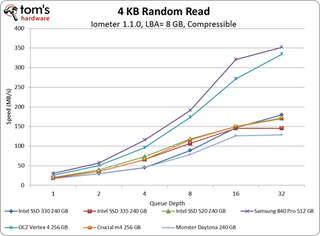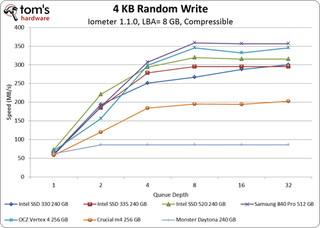Intel SSD 335 240 GB Review: Driving Down Prices With 20 nm NAND
4 KB Random Performance
Random Read Performance (background info)
Examples include antivirus scans and typing in Word

The SSD 330 was Intel's answer to SSDs from competing brands with asynchronous NAND, such as OCZ and its Agility 3 or Corsair and its Force 3. We have Monster's 240 GB Daytona to stand in for that comparison.
But Intel didn't use asynchronous memory. It instead armed the SSD 330 synchronous flash and deliberately de-tuned performance via firmware. The SSD 335 being introduced today is largely similar. Meanwhile, Intel's SSD 520 represents performance-oriented SandForce-based SSDs equipped with synchronous NAND and not purposely slowed-down.
At a queue depth of one, all of the SSDs start out by moving between 25-30 MB/s. The picture is quite a bit different once we scale up to 32 outstanding I/O requests. Between those two extremes, Samsung's 840 Pro proves itself the fastest drive, while OCZ's Vertex 4 trails slightly. None of the drives based on SandForce's controller hardware fare as well, though Intel does manage to score a win over the Daytona using its SSD 335.
Random Write Performance
Examples include email, file compression, and Web browsing
Stay on the Cutting Edge
Join the experts who read Tom's Hardware for the inside track on enthusiast PC tech news — and have for over 25 years. We'll send breaking news and in-depth reviews of CPUs, GPUs, AI, maker hardware and more straight to your inbox.

The most glaring data point is Monster's 240 GB Daytona, which doesn't break 100 MB/s all the way through a queue depth of 32. We have an email out to the company asking if this is something they've seen. We know from testing OCZ's 180 GB Agility 3 that performance should end up somewhere close to 300 MB/s.
Between the starting and ending points, Intel's SSD 335 generally outmaneuvers its 240 GB predecessor, even if they appear identical at a queue depth of one and 32. As it should, Intel's SSD 520 maintains an advantage over both 300-series drives.
But of course, Samsung's 840 Pro steals the show, albeit at a price point far higher than the SSD 335.
Current page: 4 KB Random Performance
Prev Page Test Setup And Benchmarks Next Page 128 KB Sequential PerformanceMost Popular

